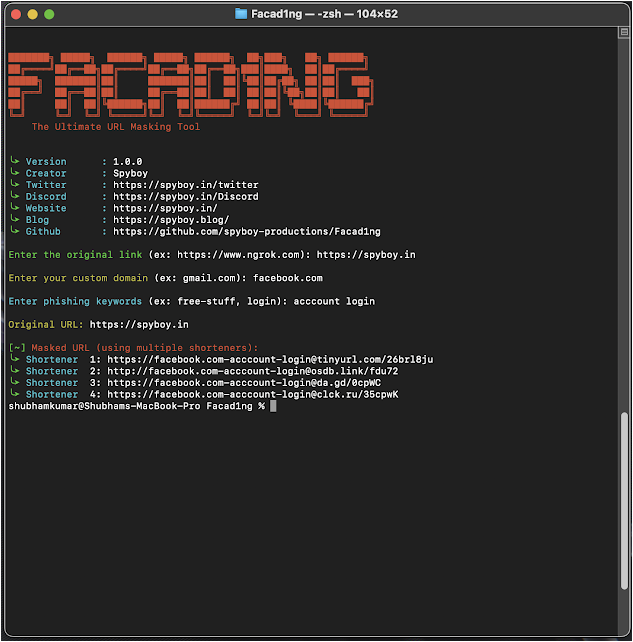Facad1ng – The Ultimate URL Masking Tool – An Open-Source URL Masking Tool Designed To Help You Hide Phishing URLs And Make Them Look Legit Using Social Engineering Techniques
Facad1ng is an open-source URL masking tool designed to help you Hide Phishing URLs and make them look legit using social engineering techniques.
Your phishing link: https://example.com/whatever
Give any custom URL: gmail.com
Phishing keyword: anything-u-want
Output: https://[email protected]/yourlink
# Get 4 masked URLs like this from different URL-shortener
URL Masking: Facad1ng allows users to mask URLs with a custom domain and optional phishing keywords, making it difficult to identify the actual link.
Multiple URL Shorteners: The tool supports multiple URL shorteners, providing flexibility in choosing the one that best suits your needs. Currently, it supports popular services like TinyURL, osdb, dagd, and clckru.
Input Validation: Facad1ng includes robust input validation to ensure that URLs, custom domains, and phishing keywords meet the required criteria, preventing errors and enhancing security.
User-Friendly Interface: Its simple and intuitive interface makes it accessible to both novice and experienced users, eliminating the need for complex command-line inputs.
Open Source: Being an open-source project, Facad1ng is transparent and community-driven. Users can contribute to its development and suggest improvements.
git clone https://github.com/spyboy-productions/Facad1ng.git
cd Facad1ng
pip3 install -r requirements.txt
python3 facad1ng.py
PYPI Installation : https://pypi.org/project/Facad1ng/
pip install Facad1ng
Facad1ng <your-phishing-link> <any-custom-domain> <any-phishing-keyword>
Example: Facad1ng https://ngrok.com gmail.com accout-login
import subprocess
# Define the command to run your Facad1ng script with arguments
command = ["python3", "-m", "Facad1ng.main", "https://ngrok.com", "facebook.com", "login"]
# Run the command
process = subprocess.Popen(command, stdout=subprocess.PIPE, stderr=subprocess.PIPE)
# Wait for the process to complete and get the output
stdout, stderr = process.communicate()
# Print the output and error (if any)
print("Output:")
print(stdout.decode())
print("Error:")
print(stderr.decode())
# Check the return code to see if the process was successful
if process.returncode == 0:
print("Facad1ng completed successfully.")
else:
print("Facad1ng encountered an error.")A considerable amount of time and effort goes into maintaining this website, creating backend automation and creating new features and content for you to make actionable intelligence decisions. Everyone that supports the site helps enable new functionality.
If you like the site, please support us on “Patreon” or “Buy Me A Coffee” using the buttons below
To keep up to date follow us on the below channels.



![Black Basta Ransomware Victim: thelawrencegroup[.]com_privat 7 Basta](https://www.redpacketsecurity.com/wp-content/uploads/2022/06/Basta-300x97.png)
